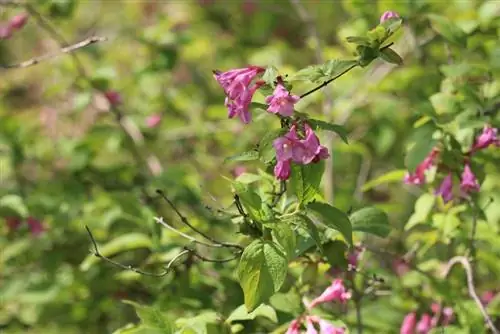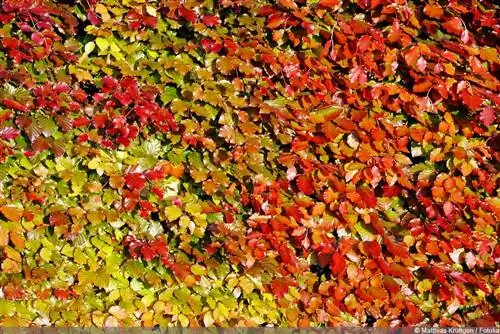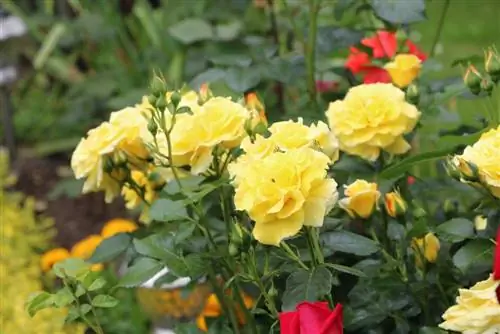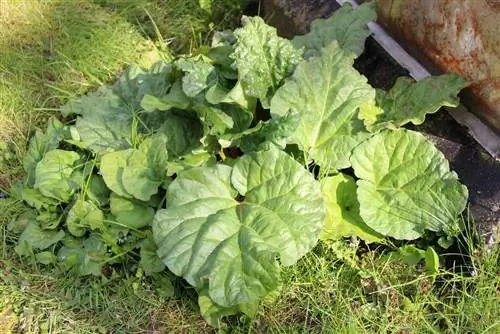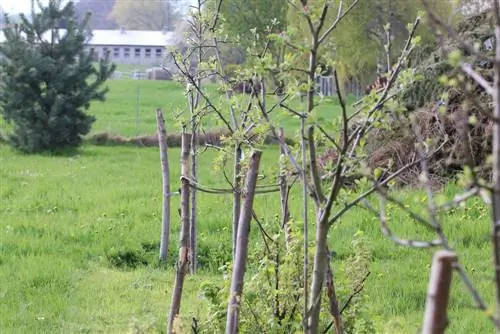- Author admin [email protected].
- Public 2023-12-17 03:39.
- Last modified 2025-01-24 12:45.
With their early summer blooms, weigelias bridge the transition between spring and summer blooms in the bed and on the balcony with lavish splendor. The right cut encourages the flowering bushes to bloom again in autumn. To ensure that the Asian pieces of jewelry retain their floral liveliness, maintenance pruning effectively prevents them from declining in bloom. Scissors therefore play a central role in the care of Weigelia. These instructions explain all cutting measures in detail and provide tangible information at the best time.
Schedule for cutting measures
The Weigela thrives as a spring bloomer with the potential for autumnal rebloom. As is characteristic of the honeysuckle family, it places the buds on the old wood for the next year's flowering period. These winter buds are located in the leaf axils, on the short side branches or grow terminally. This growth behavior requires a targeted strategy for pruning measures over the course of the year. The following overview shows the best time in each case:
- Topiary pruning: In June/July after the flowering period
- Maintenance cut: In late winter
- Rejuvenation cut: In January/February
- Pruning: Immediately after planting in spring or autumn
There should be neither sweltering heat nor blazing sunshine or rainy weather in summer at the specific date for a cut. In winter, pruning measures are successful when the mercury column is above freezing point.
The recommended times also comply with the Federal Nature Conservation Act. In paragraph 39, the legislature stipulates that no radical pruning of bushes and hedges may be carried out between March 1st and September 30th. This requirement is essentially made to protect breeding birds. Light maintenance pruning is permitted provided that the wood has been carefully examined for habitats of wild animals and has been identified as uninhabited.
Instructions for topiary
The special appeal of a weigela lies in the opulent density of flowers and the elegant, slightly overhanging branches. Moderate pruning at the end of the first round of flowering helps ensure that the flowering shrub retains its beauty for many years. This cut may not be absolutely necessary when young, as the weigela still grows tightly upright and compact.
As the flowering bush gets older, it tends to senesce, with fewer and fewer buds forming on the branches, the branches becoming bare inside and the entire bush falling apart. We would therefore like to recommend the following pruning procedure right from the start in order to prevent more extensive pruning in good time. How to do it right:
- In the first 3 to 4 years, shorten the branches by about a third
- On older weigelias, cut off shoots that are too long by 30 to 40 cm
- Make the incision 1-2 cm above each sleeping eye

For many Weigelia varieties, pruning in early summer stimulates autumnal re-blooming. Just clean these out before the start of winter, as the shrub has in the meantime put on the buds for next year's main flowering. If you want to sow the Asian beauty yourself, wait until late winter before cleaning it out, when maintenance pruning is on the care program.
Tip:
Before each pruning, the weigela is thoroughly examined for nests of breeding birds or refuges of other small animals. According to the Federal Nature Conservation Act, wild animals may not be disturbed in their habitat at any time of the year. If necessary, the date for the cut will be postponed.
Guide to Conservation Pruning
An ornamental shrub can only carry out photosynthesis where sunlight reaches its shoots. Maintenance pruning aims to completely remove dead wood in order to create airy yet compact growth. In principle, this cutting measure could be combined with the maintenance cutting in June, which, however, does not comply with the Federal Nature Conservation Act, which prohibits extensive cutting measures at this time. When your weigela is in its dormant state in late winter, it is the best time for the following pruning:
- Cut off dead branches at ground level
- From branches that are too close together, cut off the weaker or older ones at the fork
- Cut shoots with the direction of growth towards the inside of the bush to an outward-facing eye
- Cut back frozen young shoots to he althy wood
Limit conservation pruning to dead, weak and misaligned wood. The buds on all vital branches are already waiting in late winter to unfold on time in May. On the leafless branches, the flowers and leaves can be seen as a slight elevation under the bark. If you have doubts about whether a shoot is actually dead or frozen, a vitality test will help you make a decision. Using a sharp, disinfected knife blade, scrape off a little of the bark. If you can see dark brown tissue underneath, you can cut it here. Green tissue, on the other hand, indicates a living branch.
Radical rejuvenation cut
A weigela that has not been cut for several years can be brought back into life with a courageous pruning. The only disadvantage of rejuvenation is the loss of the next flowering period. Since an unpruned ornamental shrub hardly produces any flowers anyway, this shortcoming can be overcome. This process has proven to be effective for rejuvenating weigela:
- In January/February, cut off all shoots up to 30 cm high
- Additionally thin out all dead wood close to the ground
- Apply a thin layer of wound paste or clay to the edges of large cuts
During the following growing season, numerous young shoots sprout from the cut main branches. You can give them a free hand until next winter and then select the best specimens with targeted conservation pruning. For this purpose, select between 4 and 5 strong young shoots per main shoot and shorten them by a third to half of the growth. Cut all other branches to Astring.
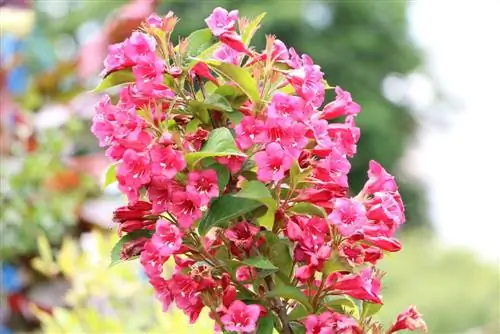
To do this, place the scissors just in front of the bark or the small bulge. The weigela blooms for the first time on this base structure in the second year. With the maintenance pruning after the flowering period, the normal rhythm of annual shape and maintenance pruning begins.
Tip:
With continuous rejuvenation you can specifically avoid radical pruning and the subsequent loss of flowering. From the fourth year onwards, the two oldest main shoots are cut off close to the ground at two-year intervals. Young ground shoots use these gaps to sprout directly from the roots so that the weigela cannot age.
Planting pruning with tips for raising people
A bushy growth from the base to the tips does not have to remain a pipe dream on weigela. You can set the course for perfect growth immediately after planting in spring or autumn. In tree nurseries and garden centers, inexpensive young weigelias are usually available as container plants with a height of 60 to 100 cm and an average of 3 main shoots.
This growth does not provide the ideal conditions for the picturesque appearance that we hope for from a weigela. With the following planting pruning and professional training, you can direct the flowering bush into a densely bushy, elegant and flower-rich appearance:
- Plant the young weigela in a sunny to partially shaded location
- Then shorten all shoots by a third to a maximum of half
- Make each cut approximately 1 cm above a leaf node
This cut naturally reduces the number of flowers in the first year. The advantage lies in further branching at the interfaces, so that the weigela develops a bushy habit from the base. By cutting the branches again by a third in the following two years after the flowering period, the dense growth will continue.
Suitable tool for densely bushy weigela
Simple garden or rose scissors are well suited for cleaning out withered flowers or for light pruning after flowering. The choice of cutting tool becomes more difficult when old wood is cut out or dead wood is thinned out on a densely branched weigela. You can't even use conventional pruning shears here with the extended handles.
There is no room for even the smallest saw in the middle of the bush or there is a risk of injuring other branches. In order to precisely remove a thick branch from the almost impenetrable branches of a weigela, specialist retailers have special shrub shears available. This clever design extends the handles away from the cutting head.
In addition, the cutting head can be rotated so that you can easily reach any branch, grasp it with the blades and cut it off. The practical shrub shears have an impressive price at around 100 euros, but are useful in many other areas of use in the garden. This is how thorny rose bushes can be cut with smart scissors without painful skin injuries.
Care after pruning
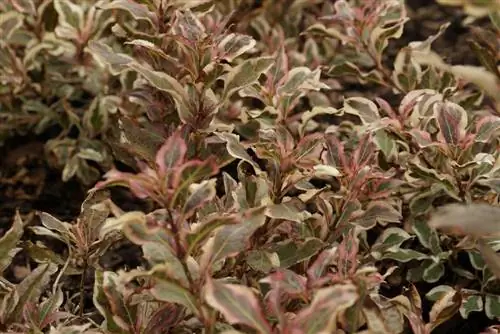
Only in combination with a balanced supply of water and nutrients do the pruning measures described achieve an optimal result. The weigela thrives as a shallow rooter, so it can come under drought stress during hot summer days. Therefore, water regularly as soon as the soil surface has dried. A layer of mulch made of leaves is advantageous, as it prevents them from drying out quickly. The following nutrient supply is beneficial for growth and rich flowers:
- Fertilize organically after maintenance pruning in late winter
- Sprinkle 3 liters of ripe compost on the root disk, rake in lightly and water
- Fertilize again after topiary in summer
The natural winter hardiness of your weigela is optimized by spraying the root disc with potassium-rich comfrey manure in July and August. This main nutrient is able to lower the freezing point in cell water and strengthen cell tissue.
Conclusion
The weigela naturally develops a harmonious silhouette and lush flowers, which does not necessarily require extensive pruning. With a light topiary cut after flowering and a maintenance cut in late winter, you preserve the natural habit and promote the flowering. If the flowering bush has been given professional pruning, bushy, compact growth from the base is ensured. As part of continuous rejuvenation, you can counteract aging in a timely manner. If an emergency does occur, the floral spirit of life can be awakened with a radical rejuvenation cut in the Asian ornamental tree. These instructions explain the correct cutting procedure and indicate the best time. If the weigela receives ripe compost after each cut, you have done everything right.

